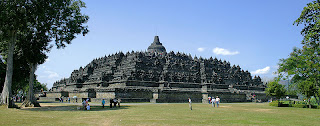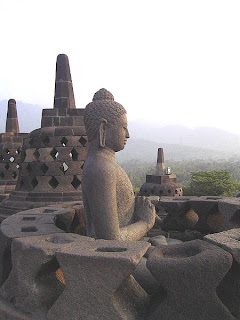
Perhaps Mount Merapi had erupted, choking the rice lands with layers of volcanic ash. Whatever the cause, the population moved to East Java in a mass exodus, and Borobudur was left behind, its meaning lost in time. Some scholars believe that famine caused by an eruption of Mount Merapi forced the inhabitants of Central Java to leave their lands behind in search of a new place to live. When people once again inhabited this area, the glory of Borobudur was buried by ash from Mount Merapi.
Northwest View of Borobudur
Mountain peaks, according to Buddhist thought, are the place where contact with divine truth may take place. Pilgrims today and yesterday would climb Borobudur level by level, drawing closer and closer to complete infusion by divine wisdom. Essentially, the pilgrim can experience nirvana on earth. Borobudur has the mound shape of a stupa, the most typical Buddhist structure honouring Buddha. It is made of square and round terraces, topped by a dome-like structure.
One of The Damaged Stupa with Buddha Statue Inside It
The terraces symbolise the three levels of the Buddhists’ cosmological system: the world of desire, the world of form without desire and the world of formlessness. These layers also depict the three steps of spiritual growth towards salvation.
Borobudur was rediscovered in 1814 by Sir Thomas Stamford Raffles, the British governor of Indonesia who, during his visit in Semarang, now the capital city of Central Java, received a report indicating the discovery of a hill full of many carved stones. The hill was believed by the local inhabitants to be the site of an ancient monument called budur. Raffles then commissioned a team led by Cornelius to investigate the hill. He was responsible for the excavation of Borobudur at that time, speculated that Borobudur may have originally been a holy place of pilgrimage for believers of the Mahayana branch of Buddhism. Monks from the nearby monastery would have led pilgrims along the galleries, using the carved panels to illustrate the stories of their faith and the way of the Buddha as they circled their way to the top of the monument.
Lacking further historical information, Raffles was unable to determine the exact date of Borobudur's construction. But he knew that in the 13th and 14th centuries, Islam had replaced Buddhism as the island's religion, and he thought it unlikely that Borobudur would have been built since then. Also, ancient records showed that in the 10th century, the region around Borobudur had been mysteriously deserted, and all construction in central Java had stopped then. From the detailed carvings, Raffles concluded that Borobudur had been built sometime between the eighth and tenth centuries, during a period of relative peace in East Asia, after the nomadic and religious invasions had run out of steam.
It was in 1835 that the site was cleared. Some efforts were made to restore and preserve the colossal monument since then. Unfortunately, in 1896 the Dutch colonial government gave away eight containers of Borobudur stones, including reliefs, statues, stairs and gates, as presents for the King of Siam who was visiting Indonesia. A restoration program undertaken between 1973 and 1984 returned much of the complex to its former glory, and the site has since become a destination of Buddhist pilgrimage. On January 21, 1985 the temple suffered minor damage due to a bomb attack. In 1991, Borobudur was listed by UNESCO as a World Heritage Site. The colossal monument consists of six rectangular terraces topped by three concentric circular terraces.
Four of the terraces are galleries, each enclosed by a balustrade and an inner wall, open to the sky and carved with sculptures. At first sight, the square galleries are an overwhelming mass of images depicting the activities of gods and mortals carved in the dark volcanic stone along the wide processional paths. There are more than 1,300 narrative panels illustrating the life of Buddha and Buddhist texts, the largest and most complete collection of Buddhist reliefs in the world. Originally, there were over 500 statues of the Buddha, 432 seated in lotus position on the square terraces and 72 meditating inside the bell-shaped stupas on the top terraces. There are no elaborate carvings on these three upper levels.
Some scholars think that this massive monument is a gigantic textbook of Buddhism to help people to achieve enlightenment. To read this Buddhist textbook in stone requires a walk of more than two miles. The walls of the galleries are adorned with impressive reliefs illustrating the life of Buddha Shakyamuni and the principles of his teaching. Representing the existence of the universe, Borobudur perfectly reflects the Buddhist cosmology, which divides the universe into three intermingled separate levels. The three levels are Kamadhatu (world of desire), Ruphadatu (world of forms), and Arupadhatu (world of formlessness).
In 1885 J.W. Ijzerman Chairman, an archaeologists of the Archeological Society in Yogyakarta discovered a ‘hidden base’ that was located behind the exterior wall of the lowest terrace, it has been built around the monument with 160 stone reliefs, 157 of which were covered and just 3 visible. In 1890-91, the complete ‘hidden base’ was exposed, photographed and encased again. Why the reliefs were ever covered up remains a mystery. There are various theories circulating, varying from structural explanations (the cover plates created a stronger base for the stupa) to iconographic ones (the sight and significance of the pictures was not supposed to be visible to everyone).
It is thought that during construction Borobudur experienced a landfall that threatened the entire building. To prevent the whole monument from collapsing, the Kamadhatu level was closed and made into a new base that holds Borobudur steady. This discovery brings about renewed efforts to safeguard Borobudur from vandalism and natural threats. The hidden base of Borobudur was originally the first level, which contains the gallery of Kamadhatu level.
Mahakamavibhanga (Causes of Good Health); Relief 20 from the Hidden Base, East Side, South End
Mahakamavibhanga (Causes of Good Health); Relief 20 from the Hidden Base, East Side, South End
One will be born as the child of a great king
One will have a noble body
One will become beautiful and very attractive
One will have sharp sense faculties One will be powerful and famous
One will have a great entourage of servants
One will become a leader of men
One will be a support to all
One will be renowned in the ten directions
One will be able to express oneself in words and verses extensively
One will receive offerings from men and gods
One will possess many riches
One will obtain the kingdom of a universal monarch
One will have long life
One's body will be like a collection of vajras
One's body will be endowed with the major marks and the minor signs (of a Buddha) One will take rebirth in the three higher realms
One will swiftly attain complete nirvana
These eighteen points are the benefits of building a Tathagata Stupa." Elsewhere in the text the Buddha says the following:
"If in this life you often use harsh speech to irritate others, and if you delight in exposing their private matters, and if you are stubborn and unyielding, then in your next life you will be born as a fire-spewing hungry ghost." We may derive additional information concerning the contents of this text by examining the version of the Mahakarmavibhangga that appears in the Pali Canon of Theravada Buddhism. In the Pali version of the text, the Sakyamuni presents a discourse in which he describes various human actions and their corresponding results. He begins by listing the ten wrongful actions of the evil-doer: killing living beings, stealing, engaging in sexual misconduct, speaking falsely, speaking maliciously, speaking harshly, engaging in gossip, coveting that which belongs to others, harboring ill will toward others, and holding wrongful views. In addition, he delineates the ten rightful actions, which consist of abstention from committing the aforementioned ten wrongful activities.
According to the Buddha, the minds of individuals are complex, generating a variety of karmic results within a single lifetime. The result of any karmic action may not even be realized during the same existence in which the act has been committed. Moreover, it is incorrect to presume that the evildoer always goes to hell, or that the good man always goes to heaven. Instead, the Buddha lists four possible outcomes concerning the evildoer who goes to hell, the evil doer who goes to heaven, the good man who goes to heaven, and the good man who goes to hell. It is entirely possible, said the Buddha, that any good actions that a person commits just before death could result in an evildoer going straight to heaven. Or the evil actions of a person committed just before death could cause someone whom had previously performed numerous acts of merit to go straight to hell upon the dissolution of the body. However, neither heaven nor hell is to be regarded as a permanent condition.
Each individual will eventually be reborn into future existences where the karma they have generated during previous lives will inevitably exert its effect. The main theme of these hidden reliefs is reward and retribution. Besides pictures of heaven and hell, there are scenes from daily life, worldly successes and dramas, good and bad things that are interconnected with deeds from the past and that determine whether reward or retribution is awaiting a person in the future. At the same time, the reliefs present a picture of day-to-day life on Java at the end of the eight and ninth century.
There is a scene for example in which there are monks shown on the right, receiving donations of food and drink (good deed); at the left of the same relief one sees how those who donated the food and drink are living a life of plenty, blessed with love, beauty and status – the reward. This level of Kamadhatu pictures the world of passion and the inevitable laws of karma. The first 117 panels show various actions leading to one and the same result, while the other remaining 43 panels demonstrate the many results that follow one single effect. At least 160 relief panels were carved around this level, based on the manuscript of Karmavibhangga. What is left of these can be seen in the Southeast corner of this level.
The next level is Rupadhatu level, it show the stories based on the manuscripts of Lalitavistara, Jataka-Avadana and Gandavyuha. The Lalitavistara reliefs, consisting of 120 panels, tell us about the life of Siddhartha Gautama Buddha. It starts with the glorious descent of Buddha from the Tushita heaven. Born as Prince Siddhartha, Buddha's childhood was isolated from the outside world's misery. Accidentally witnessing the misery of sickness, decrepitude and death, young Prince Siddharta decided to escape from the worldly life and commencing his search of freedom from suffering. Siddhartha’s long and painful search finally led him to the highest level of enlightenment and made him Buddha, the Enlightened One. This story ends with Buddha’s sermon in the Deer Park near Benares.
The Jataka is a collection of stories about Buddha's previous reincarnation, chains and virtues. According to the Jataka, Buddha was born 504 times before being born as Prince Siddharta, taking on the forms of god, kings, princes, learned men, thieves, slaves, and a gambler. Many times he was born in the forms of animals such as lion, deer, monkey, swan, big turtle, quail, horse, bird and many others. But the Boddhisatva (Buddha-to-be) was distinguished from all other kings, slaves, or animals among whom he lived. The Boddhisatva is always superior and wiser than those around him.
As to the relief of Avadana, the main figure is not the Buddha himself. All the saintly deeds pictured in this part are attributed to other legendary characters. The stories are compiled in Dvijavadana (Glorious Heavenly Acts) and the Avadana Sataka (The Hundred Avadana). The first 20 frames in the lower series of stories on the first gallery depict the Sudhanakumaravana. The series of reliefs covering the wall of the second gallery is dedicated to Sudhana’s tireless wandering during his search for the highest wisdom. The story is continued on the walls and balustrades of the third and fourth galleries. Most of the 460 panels depict the scenes based on the Mahayana text Gandavyuha, while the concluding scenes are derived from the text of Badracari.
On the last three circular uppermost terraces or Arupadhatu level, consists of 72 stupas circle the huge main stupa that crowns the top of the temple. The circular form represents the eternity without beginning and without end, a superlative, tranquil, and pure state of the formless world. There are no reliefs on the three circular terraces. All but the largest central stupas on the upper levels contain a (more or less) life-sized statue of the Buddha kneeling, although many of these statues are missing or damaged.
There are also many alcoves along the lower levels which contain similar statues but many of these are missing or damaged as well. As a testament in stone Borobudur is remarkable, but even without its religious implications the art of the carved reliefs would ensure it a high place among the world’s greatest monuments.






0 comments:
Post a Comment